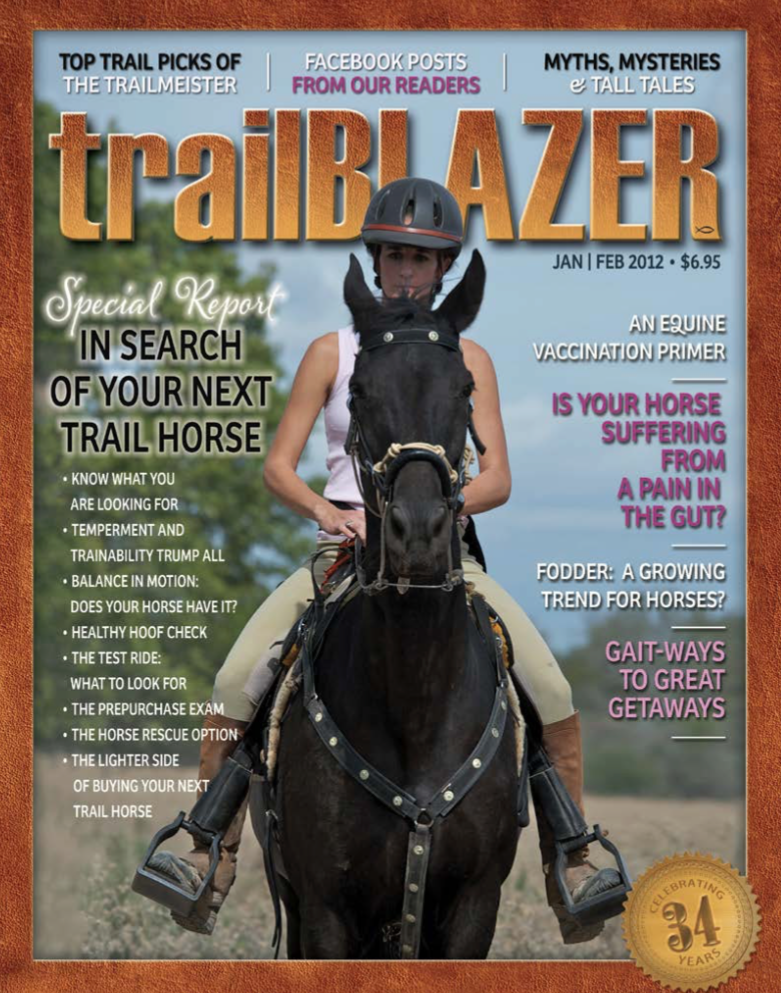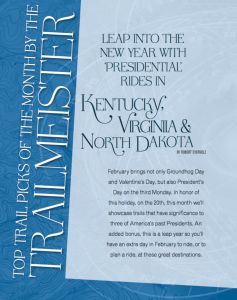 Leap into the New Year With Presidential Rides in Kentucky, Virginia, and North Dakota
Leap into the New Year With Presidential Rides in Kentucky, Virginia, and North Dakota
By Robert TrailMeister Eversole
As published in TrailBlazer Magazine, January / February 2012
February brings not only Groundhog Day and Valentine’s Day, but also President’s Day on the third Monday. In honor of this holiday, on the 20th, this month we’ll showcase trails that have significance to three of America’s past Presidents. An added bonus, this is a leap year so you’ll have an extra day in February to ride, or to plan a ride, at these great destinations
Mammoth Cave National Park, Kentucky
Mammoth Cave National Park is located just an hour south of President Abraham Lincoln’s February 12, 1809, Hodgenville, Kentucky birthplace. Not only is Mammoth Cave near Lincoln’s birthplace, it is also very convenient to the metropolitan complexes of Louisville and Lexington, Kentucky and Nashville, Tennessee. For riders within this area, Mammoth makes for fantastic camping, and also almost unparalleled day riding opportunities.
For those in the know Mammoth Cave National Park is much more than 392 miles of cold, dank underground caverns, it’s also 60 miles of exquisite horseback riding trails for those that choose the sunny side of life. With easy to moderately challenging trails, multiple loop routes, scenic views, babbling brooks, waterfalls, rolling hills and steep ravines, the trails here offer a bit of everything that a trail rider could want.
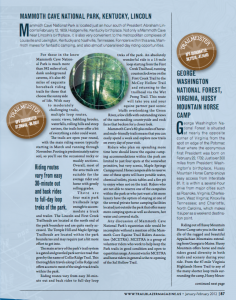 The trails are open year round, with the main riding season typically starting in March and running through November. Footing is predominately native soil, so you’ll see the occasional rocky or muddy sections. Overall, most of the area trails are suitable for the average rider and horse with gently rolling grades. There are four main park trailheads large enough to accommodate a truck and trailer. The Lincoln and First Creek Trailheads are located at the north end of the park boundary and are quite easily accessed. Thee Temple Hill and Maple Springs Trailheads are located within the park boundaries and may require just a bit more effort to get into. The main artery of the park’s trail system is a gated and graveled park service road that goes by the name of Collie Ridge Trail. is thoroughfare travels along Collie Ridge and offers access to most of the single track trails within the park.
The trails are open year round, with the main riding season typically starting in March and running through November. Footing is predominately native soil, so you’ll see the occasional rocky or muddy sections. Overall, most of the area trails are suitable for the average rider and horse with gently rolling grades. There are four main park trailheads large enough to accommodate a truck and trailer. The Lincoln and First Creek Trailheads are located at the north end of the park boundary and are quite easily accessed. Thee Temple Hill and Maple Springs Trailheads are located within the park boundaries and may require just a bit more effort to get into. The main artery of the park’s trail system is a gated and graveled park service road that goes by the name of Collie Ridge Trail. is thoroughfare travels along Collie Ridge and offers access to most of the single track trails within the park.
Riding routes vary from easy 30-minute out and back rides to full-day loop treks of the park. An absolutely wonderful ride is a 15-mile loop starting from the First Creek Trailhead, running counterclockwise on the First Creek Trail to the McCoy Hollow Trail and returning to the trailhead via the Wet Prong Trail. This route will take you and your equine partner past scenic bluffs overlooking the Green River, a few cliffs with outstanding views of the surrounding countryside and rock faces that beckon for a closer look. Mammoth Cave’s 60-plus miles of horse- and mule-friendly trails means that you can easily spend a week and explore new trails on every day of your visit.
Riders who plan on spending more time here should know the equine camping accommodations within the park are limited to just four spots at the somewhat primitive, but very scenic, Maple Springs Campground. Horse campers able to reserve one of these spots will have potable water, chemical toilets, picnic tables and a re pit to enjoy when not on the trail. Riders who are not able to reserve one of the campsites within the park or who just want a bit more luxury have the option of staying at one of the several private horse camping facilities located just outside the park that offer many more camping spots as well as showers, hot water and covered stalls.
Any discussion of Mammoth Cave National Park’s equestrian side would be incomplete without a mention of the Mam- moth Cave Equine Trail Riders Association (MCET). MCET is a group of volunteer riders who work to help keep the Park trails in good condition and open to equestrian usage. A recent win for MCET and horse riders in general is the re-opening of the Sal Hollow Trail.
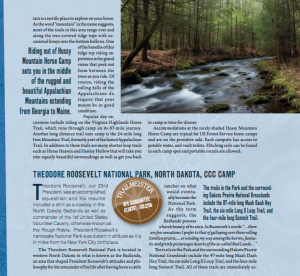 George Washington National Forest, Hussy Mountain Horse Camp, Virginia
George Washington National Forest, Hussy Mountain Horse Camp, Virginia
George Washington National Forest is situated at nearly the opposite corner of Virginia from the spot on edge of the Potomac River where the eponymous first President was born on February 22, 1732. Just over 300 miles from President Washington’s birthplace, Hussy Mountain Horse Camp enjoys easy access from Interstate 81. It is within a several-hour drive from major cities such as Roanoke, Virginia; Charles- town, West Virginia; Knoxville Tennessee; and Charlotte, North Carolina, which makes it super as a weekend destination point.
Riding out of Hussy Mountain Horse Camp sets you in the middle of the rugged and beautiful Appalachian Mountains extending from Georgia to Maine. Hussy Mountain offers horse and mule riders grand diversity in both trails and scenery during your ride. From the 67-mile Virginia Highlands Horse Trail to any of the many shorter loop trails surrounding the camp, Hussy Mountain is a terrific place to explore on your horse. As the word “mountain” in the name suggests, most of the trails in this area range over and along the tree-covered ridge tops with occasional forays into the bottom hollows. One of the benefits of this ridge top riding experience is the grand vistas that peek out from between the trees as you ride. Of course, riding the rolling hills of the Appalachians do require that your mount be in good condition.
Popular day excursions include riding on the Virginia Highlands Horse Trail, which runs through camp on its 67-mile journey. Another long distance trail near camp is the 24-mile long Iron Mountain Trail, formerly part of the famed Appalachian Trail. In addition to these trails are many shorter loop trails such as Horse Heaven and Henley Hollow that will take you into equally beautiful surroundings as well as get you back to camp in time for dinner.
Accommodations at the nicely shaded Hussy Mountain Horse Camp are typical for US Forest Service horse camps and are on the primitive side. Each campsite has access to potable water, and vault toilets. Hitching rails can be found in each camp spot and portable corrals are allowed.
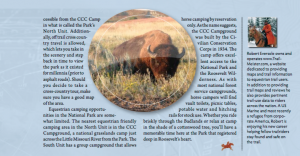 Theodore Roosevelt National Park, CCC Camp North Dakota
Theodore Roosevelt National Park, CCC Camp North Dakota
Theodore Roosevelt, our 23rd President, was an accomplished equestrian and his resume included a stint as a cowboy in the North Dakota Badlands as well as commander of the 1st United States Volunteer Cavalry, otherwise known as the Rough Riders. President Roosevelt’s namesake National Park is as distant in attitude as it is in miles from his New York City birthplace.
The Theodore Roosevelt National Park is located in western North Dakota in what is known as the Badlands, an area that shaped President Roosevelt’s attitudes and philosophy for the remainder of his life after having been a cattle rancher on what would eventually become the National Park. As the term suggests, the Badlands possess a harsh beauty of its own. In Roosevelt’s words “…there are few sensations I prefer to that of galloping over these rolling limitless prairie, … or winding my way among the barren, fantastic and grimly picturesque deserts of the so-called Bad Lands… ”The trails in the Park and the surrounding Dakota Prairie National Grasslands include the 97-mile long Maah Daah Hey Trail, the six-mile Long X Loop Trail, and the four-mile long Summit Trail. All of these trails are immediately accessible from the CCC Camp in what is called the Park’s North Unit. Additionally, off trail cross country travel is allowed, which lets you take in the scenery and step back in time to view the park as it existed for millennia (prior to asphalt roads). Should you decide to take a cross-country tour, make sure you have a good map of the area.
Equestrian camping opportunities in the National Park are some-what limited. The nearest equestrian friendly camping area in the North Unit is in the CCC Campground, a national grasslands camp just across the Li le Missouri River from the Park. e South Unit has a group campground that allows horse camping by reservation only. As the name suggests, the CCC Campground was built by the Civilian Conservation Corps in 1934. The camp offers excellent access to the National Park and the Roosevelt Wilderness. As with most national forest service campgrounds, horse campers will find vault toilets, picnic tables, potable water and hitching rails for stock use. Whether you ride briskly through the Badlands or relax at camp in the shade of a cottonwood tree, you’ll have a memorable time here at the Park that registered deep in Roosevelt’s heart.


